warning light OLDSMOBILE SILHOUETTE 2003 Owners Manual
[x] Cancel search | Manufacturer: OLDSMOBILE, Model Year: 2003, Model line: SILHOUETTE, Model: OLDSMOBILE SILHOUETTE 2003Pages: 466, PDF Size: 21.55 MB
Page 2 of 466
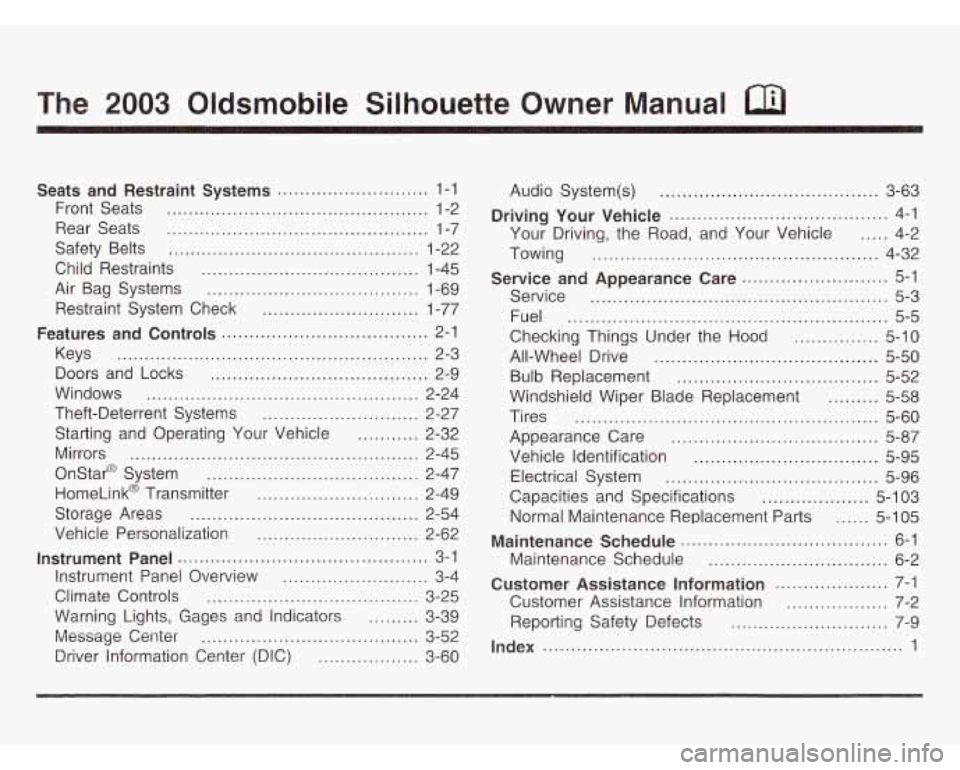
.
The 2003 Oldsmobile Silhouette Owner Manual
Seats and Restraint Systems ........................... 1-1
Front Seats
............................................... 1-2
Rear Seats
............................................... 1-7
Safety Belts
............................................. 1-22
Child Restraints
....................................... 1-45
Air Bag Systems
...................................... 1-69
Restraint System Check
............................ 1-77
Features and Controls
..................................... 2-1
Keys
........................................................ 2-3
Doors and Locks
....................................... 2-9
Windows
................................................. 2-24
Theft-Deterrent Systems
............................ 2-27
Starting and Operating Your Vehicle
........... 2-32
Mirrors
.................................................... 2-45
Onstar@ System
...................................... 2-47
HomeLink@ Transmitter
......................... 2-49
Storage Areas
......................................... 2-54
Vehicle Personalization
............................. 2-62
Instrument Panel Overview
.......................... 3-4
Climate Controls
...................................... 3-25
Warning Lights, Gages and Indicators
......... 3-39
Driver Information Center (DIC)
.................. 3-60
Instrument Panel
............................................. 3-1
Messaye Center 5-3L n r~ .......................................
Audio
System(s) ....................................... 3-63
Your Driving, the Road, and Your Vehicle
..... 4-2
Towing
................................................... 4-32
Service
..................................................... 5-3
Fuel
......................................................... 5-5
Checking Things Under the Hood
............... 5-10
All-Wheel Drive
........................................ 5-50
Bulb Replacement
.................................... 5-52
Windshield Wiper Blade Replacement
......... 5-58
Tires
...................................................... 5-60
Appearance Care
..................................... 5-87
Vehicle Identification
................................. 5-95
Electrical System
...................................... 5-96
Capacities and Specifications
................... 5-1 03
Normal Maintenance Replacement Parts
...... 5-1 05
Maintenance Schedule
................................ 6-2
Customer Assistance Information
.................... 7-1
Customer Assistance Information
.................. 7-2
Reporting Safety Defects
............................ 7-9
Driving Your Vehicle
....................................... 4-1
Service and Appearance Care
.......................... 5-1
Maintenance Schedule
..................................... 6-1
Index
................................................................ 1
Page 5 of 466
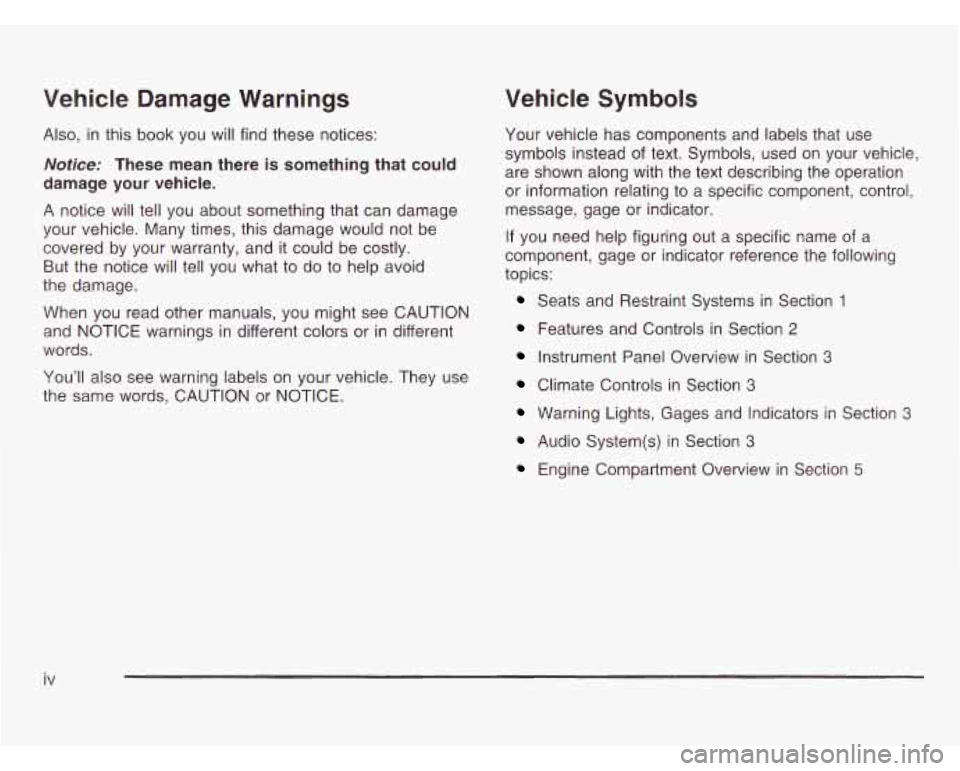
Vehicle Damage Warnings
Also, in this book you will find these notices:
Notice: These mean there is something that could
damage your vehicle.
A notice will tell you about something that can damage
your vehicle. Many times, this damage would not be
covered by your warranty, and it could be costly.
But the notice will tell you what to do to help avoid
the damage.
When you read other manuals, you might see CAUTION
and NOTICE warnings in different colors or in different
words.
You’ll also see warning labels on your vehicle. They use
the same words, CAUTION or NOTICE.
Vehicle Symbols
Your vehicle has components and labels that use
symbols instead
of text. Symbols, used on your vehicle,
are shown along with the text describing the operation
or information relating to a specific component, control,
message, gage or indicator.
If you need help figuring out a specific name of a
component, gage or indicator reference the following
topics:
Seats and Restraint Systems in Section 1
Features and Controls in Section 2
Instrument Panel Overview in Section 3
Climate Controls in Section 3
Warning Lights, Gages and Indicators in Section 3
Audio System(s) in Section 3
Engine Compartment Overview in Section 5
iv
Page 108 of 466

To close the liftgate, pull down on the handle, then
firmly shut the liftgate. Don’t drive with the liftgate open,
even slightly. See
Engine Exhaust on page 2-43.
A message in your instrument panel cluster will warn
you
if the liftgate is not completely closed. See
Rear Hatch Ajar Warning Message on page 3-58.
2-23
Page 118 of 466

B (LOCK): This is the only position from which you
can remove the key. This position locks your ignition,
steering wheel and transaxle.
Notice: If your key seems stuck in LOCK and you
can’t turn
it, be sure you are using the correct key;
if
so, is it all the way in? If it is, then turn the
steering wheel left and right while you turn the key hard. Turn the key only with your hand. Using a
tool to force
it could break the key or the ignition
switch. If none
of these works, then your vehicle
needs service.
C (OFF): This position unlocks the ignition, steering
wheel and transaxle but, does not send power to
any accessories. Use this position
if your vehicle
must be pushed or towed, but never try
to push-start
your vehicle.
D (RUN): This is the position to which the switch returns
after you start your engine and release the ignition key.
This is the position for driving. Even when the engine is
not running, you can use RUN to operate your electrical
accessories and
to display some instrument panel
warning lights.
E (START): This position starts the engine. When the
engine starts, release the ignition key. The switch
will return to RUN for normal driving.
If the engine is not running, ACCESSORY and RUN
are positions that allow you to operate your electrical
accessories, such as the radio.
Retained Accessory Power (RAP)
With RAP, the power windows, power rear quarter
windows, audio system and the automatic level control
will continue to work up to
10 minutes after the
ignition key is turned to
OFF and none of the doors
are opened.
2-33
Page 124 of 466
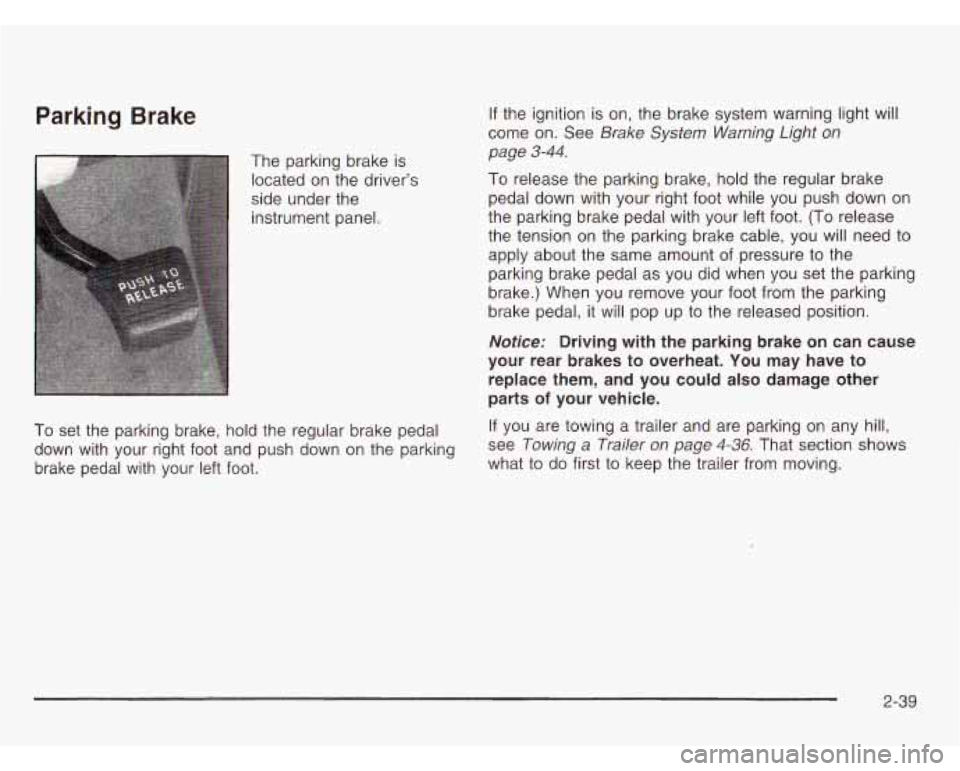
Parking Brake
The parking brake is
located on the driver’s
side under the
instrument panel.
If the ignition is on, the brake system warning light will
come on. See
Brake System Warning Light on
page 3-44.
To release the parking brake, hold the regular brake
pedal down with your right foot while you push down on
the parking brake pedal with your left foot. (To release
the tension on the parking brake cable, you will need to
apply about the same amount of pressure to the
parking brake pedal as you did when you set the parking
brake.) When you remove your foot from the parking
brake pedal,
it will pop up to the released position.
Notice: Driving with the parking brake on can cause
your rear brakes to overheat. You may have to
replace them, and you could also damage other
parts
of your vehicle.
To set the parking brake, hold the regular brake pedal If
you are towing a trailer and are parking on any
hill,
brake pedal with your left foot. what
to do first to keep the trailer from moving.
down with your right foot
and push down on the parking see
Towing a Trailer on page 4-36, That section shows
2-39
Page 158 of 466
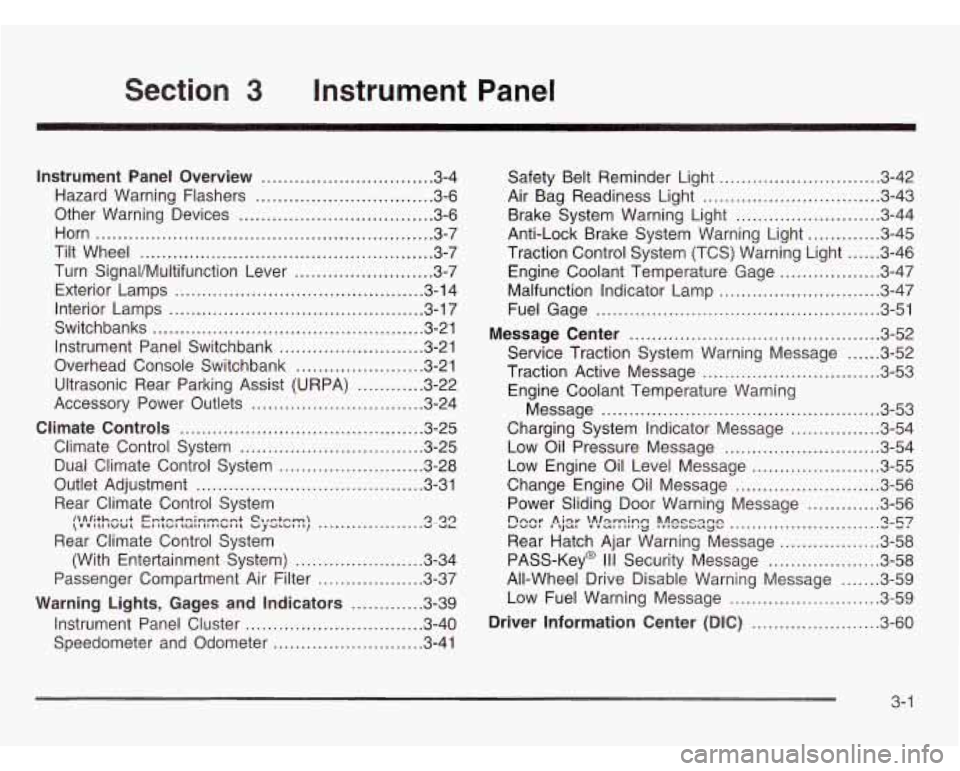
Section 3 Instrument Panel
Instrument Panel Overview ........................... 3.4
Hazard Warning Flashers
............................ 3.6
Other Warning Devices
............................... 3.6
Horn
............................................................. 3.7
Tilt Wheel
..................................................... 3-7
Turn SignaVMultifunction Lever
......................... 3.7
Exterior Lamps
............................................. 3.14
Interior Lamps
.............................................. 3.17
Switchbanks
................................................. 3.21
Instrument Panel Switchbank
.......................... 3-21
Overhead Console Switchbank
....................... 3.21
Ultrasonic Rear Parking Assist (URPA)
............ 3.22
Accessory Power Outlets
............................... 3.24
Climate Controls
............................................ 3.25
Climate Control System
................................. 3.25
Dual Climate Control System
.......................... 3.28
Rear Climate Control System
Rear Climate Control System (With Entertainment System)
...................... -3-34
Passenger Compartment Air Filter
................... 3.37
Warning Lights, Gages and Indicators
............. 3.39
Instrument Panel Cluster
................................ 3.40
Outlet Adjustment
......................................... 3.31
ilAlM-.nr I+ lZmtnwtq;n-mnt Ctrctnm \VUiLllWUL LIIL~ILUIIiIII~.. . Vy~L~..., .... ....... " "L 4-49
Speedometer and Odometer ........................... 3.41 Safety
Belt Reminder Light
............................. 3.42
Air Bag Readiness Light
................................ 3-43
Brake System Warning Light
.......................... 3-44
Anti-Lock Brake System Warning Light
............. 3-45
Traction Control System (TCS) Warning Light
...... 3-46
Engine Coolant Temperature Gage
.................. 3-47
Malfunction Indicator Lamp
............................. 3-47
Fuel Gage
................................................... 3-51
Message Center
............................................. 3-52
Service Traction System Warning Message
...... 3-52
Traction Active Message
................................ 3-53
Engine Coolant Temperature Warning
Message
.................................................. 3-53
Charging System Indicator Message
................ 3-54
Low Oil Pressure Message
............................ 3-54
Low Engine Oil Level Message
....................... 3-55
Change Engine Oil Message
.......................... 3-56
Power Sliding Door Warning Message
............. 3-56
Rear Hatch Ajar Warning Message
.................. 3-58
PASS-Key@
I II Security Message ................... -3-58
All-Wheel Drive Disable Warning Message
....... 3-59
Low Fuel Warning Message
........................... 3-59
Driver Information Center (DIC)
....................... 3-60
Eee: P, jar '!!s:n?!g !!esss;e .......................... ... Iz-c;7 v .
3- 1
Page 171 of 466
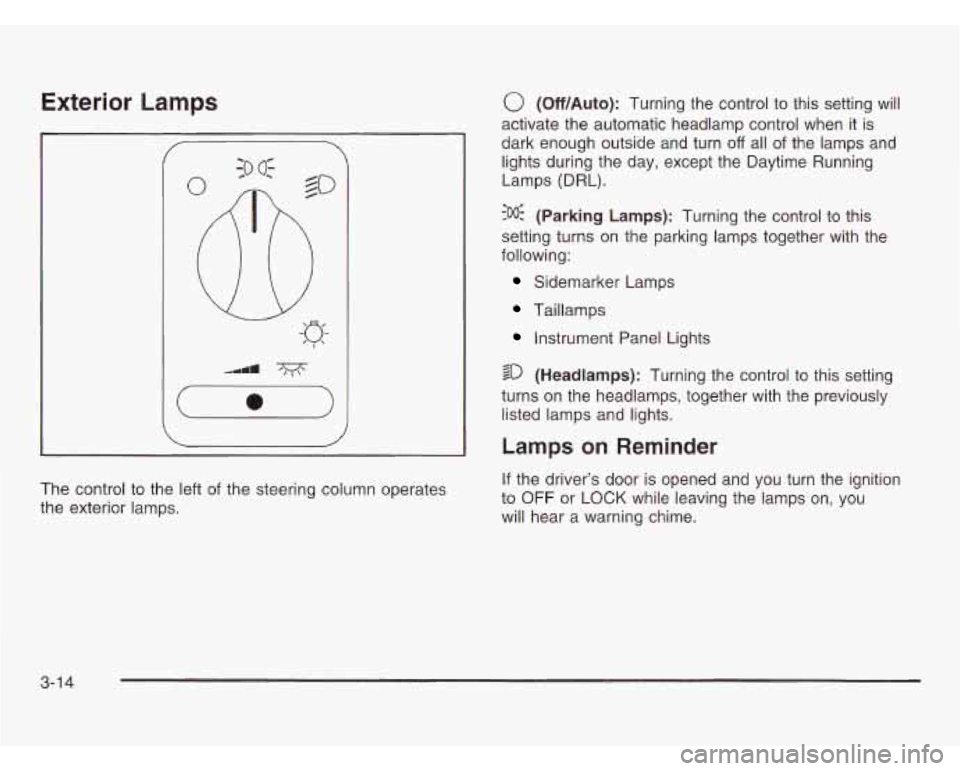
Exterior Lamps
The control to the left of the steering column operates
the exterior lamps.
0 (Off/Auto): Turning the control to this setting will
activate the automatic headlamp control when it is
dark enough outside and turn
off all of the lamps and
lights during the day, except the Daytime Running
Lamps (DRL).
?% (Parking Lamps): Turning the control to this
setting turns on the parking lamps together with the
following:
Sidemarker Lamps
Taillamps
Instrument Panel Lights
sD (Headlamps): Turning the control to this setting
turns on the headlamps, together with the previously
listed lamps and lights.
Lamps on Reminder
If the driver’s door is opened and you turn the ignition
to
OFF or LOCK while leaving the lamps on, you
will hear a warning chime.
3-1 4
Page 196 of 466

Warning Lights, Gages and
Indicators
This part describes the warning lights and gages that
may be on your vehicle. The pictures will help you
locate them.
Warning lights and gages can signal that something is
wrong before
it becomes serious enough to cause
an expensive repair or replacement. Paying attention
to your warning lights and gages could also save you or
others from injury.
Warning lights come on when there may be or is a
problem with one of your vehicle’s functions.
As you
will see in the details on the next few pages, some
warning lights come on briefly when you start the engine
just to let you know they’re working.
If you are familiar
with this section, you should not be alarmed when
this happens. Gages
can indicate when there may be or is a problem
with one of your vehicle’s functions. Often gages
and warning lights work together to let you know when
there’s a problem with your vehicle.
When one of the warning lights comes on and stays
on
when you are driving, or when one of the gages shows
there may be a problem, check the section that tells you
what to do about it. Please follow this manual’s advice.
Waiting to do repairs can be costly
- and even
dangerous.
So please get to know your warning lights
and gages. They’re a big help.
Your vehicle also has a message center that works
along with the warning lights and gages. See
Message
Center on page
3-52.
3-39
Page 197 of 466
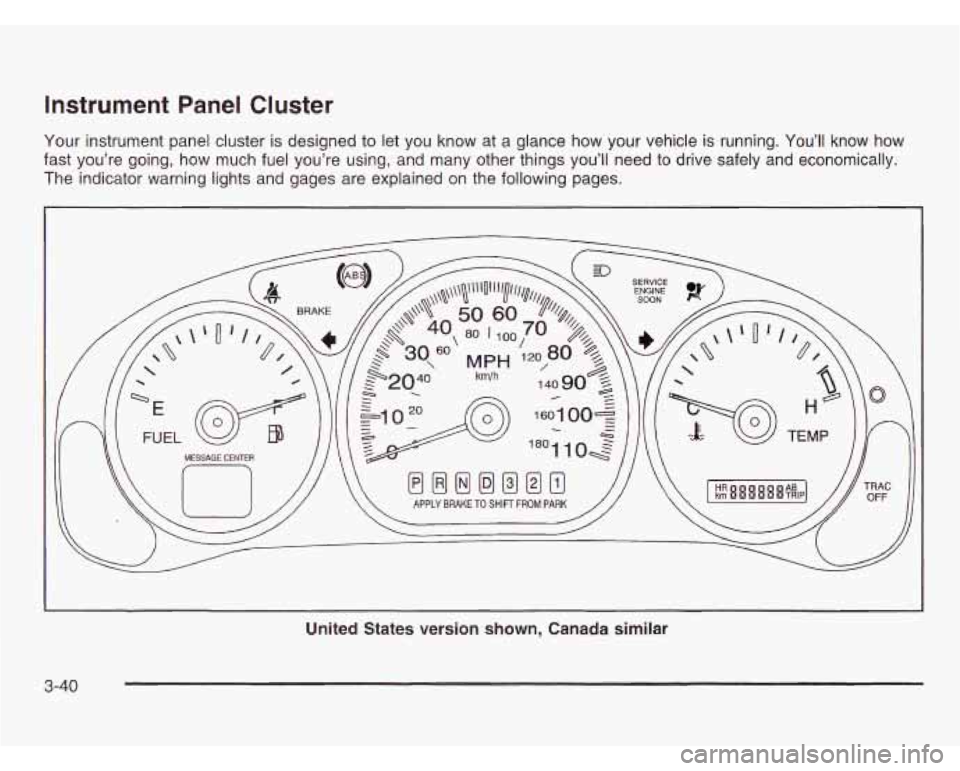
Instrument Panel Cluster
Your instrument panel cluster is designed to let you know at a glance how your vehicle is running. You’ll know how
fast you’re going, how much fuel you’re using, and many other things you’ll need
to drive safely and economically.
The indicator warning lights and gages are explained on the following pages.
United States version shown, Canada similar
3-40
Page 201 of 466
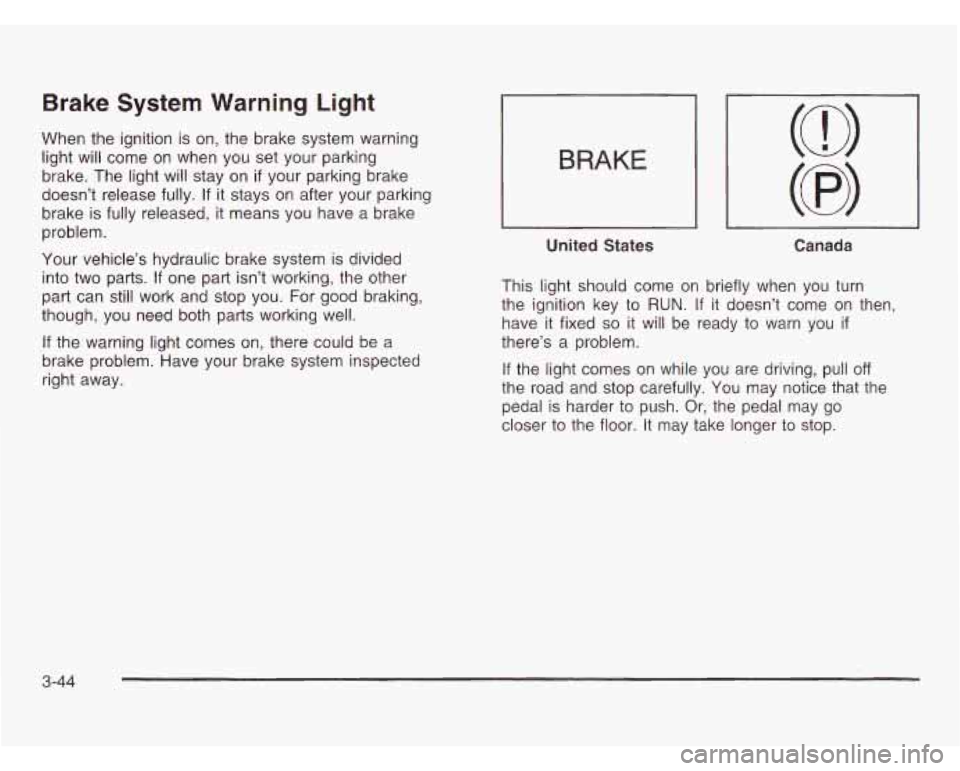
Brake System Warning Light
When the ignition is on, the brake system warning
light will come on when you set your parking
brake. The light will stay on
if your parking brake
doesn’t release fully.
If it stays on after your parking
brake is fully released, it means you have a brake
problem.
Your vehicle’s hydraulic brake system
is divided
into two parts. If one part isn’t working, the other
part can still work and stop you. For good braking,
though, you need both parts working well.
If the warning light comes on, there could be a
brake problem. Have your brake system inspected
right away.
BRAKE
United States Canada
This light should come on briefly when you turn
the ignition key to
RUN. If it doesn’t come on then,
have it fixed
so it will be ready to warn you if
there’s a problem.
If the light comes on while you are driving, pull
off
the road and stop carefully. You may notice that the
pedal is harder to push. Or, the pedal may go
closer
to the floor. It may take longer to stop.
3-44